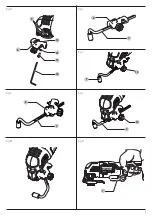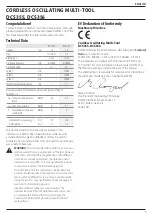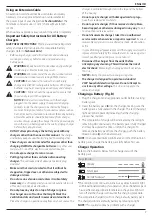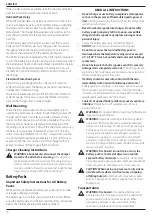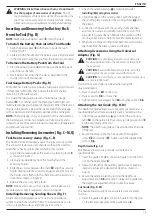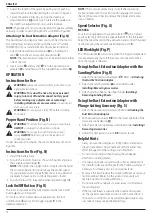
14
English
Proper hand position requires the tool to be held as shown in
Figure N.
Instructions for Use (Fig. N)
1. Install the battery pack.
2. To turn the tool ON, hold it as shown in Figure N and press
the variable speed trigger
1
.
nOTE:
The further the trigger switch is depressed the faster
the tool will operate. If in doubt about the proper speed
for your operation, test the performance at low speed and
gradually increase until a comfortable speed is found.
3. To turn the tool OFF, release the variable speed trigger
1
.
Lock On/Off Button (Fig. O)
The tool can be locked off by fully depressing the lock on/off
button
4
shown in Figure O.
For more comfort in extended use applications, the lock
on/off button
4
can lock the trigger trigger
1
in the
depressed position.
Proper Hand Position (Fig. N)
WARNING:
To reduce the risk of serious personal injury,
ALWAYS
use proper hand position as shown.
WARNING:
To reduce the risk of serious personal
injury,
ALWAYS
hold securely in anticipation of a
sudden reaction.
WARNING:
Ensure switch is fully OFF before installing
the battery.
OPERATION
Instructions for Use
WARNING:
Always observe the safety instructions and
applicable regulations.
WARNING:
To reduce the risk of serious personal
injury, turn tool off and disconnect battery pack
before making any adjustments or removing/
installing attachments or accessories.
An accidental
start-up can cause injury.
2. Adjust the length of the guide by pulling out or pushing
inward to achieve the desired length as shown in Figure L.
3. Secure the guide in place by turning the depth/cut
adjustment knob
14
clockwise. To release the guide turn
the depth/cut adjustment knob counterclockwise.
nOTE:
The guide arm can also be placed in the guard assembly
vertically in order to set the height off a cut. Refer to Figure M.
Attaching the Dust Extraction Adaptor (Fig. Q)
The Dust Extraction Adaptor allows you to connect the tool to
an external dust extractor, either using the AirLock™ system
(DWV9000‑XJ), or a standard 35 mm dust extractor fitment.
1. Attach the dust extraction adaptor
17
by inserting the
tabs
13
in to the accessory side mount slots
5
.
nOTE:
The dust extraction adaptor can be attached to either
side of the tool.
2. Insert screw
15
and washer
21
into the dust extraction
adaptor
17
and tighten with the supplied hex wrench
16
.
nOTE:
The tool will automatically shut off after operating
for five minutes with the lock‑on button engaged. To restart
the tool, the user will have to release the trigger and repress
lock‑on button.
Speed Selector (Fig. A)
DCS356
Your tool is equipped with a speed selector
10
which allows
you to select one of the three speeds that limits the full speed.
Select the speed based on the application and control the speed
of the tool using the variable speed trigger switch
1
.
LED Worklight (Fig. P)
The LED worklight
2
will activate when the trigger is depressed.
It will automatically shut off following a short period of time
once the trigger is released.
Using the Dust Extraction Adaptor with the
Sanding Platen (Fig. R)
1. Attach the dust extraction adaptor
17
. Refer to
Attaching
the Dust Extraction Adaptor
.
2. Attach the sanding platen
23
as described under
Installing/Removing Accessories
.
3. Attach sanding sheet as described under
Installing/
Removing Sanding Sheets
.
Using the Dust Extraction Adaptor with
Plunge Cutting Accessory (Fig. S)
1. Attach the dust extraction adaptor. Refer to
Attaching the
Dust Extraction Adaptor
.
2. Push dust extraction arm
19
into the lower aperture of the
dust extraction adaptor
17
.
3. Attach plunge cutting blade as described under
Installing/
Removing Accessories
.
4. Adjust the dust extraction arm
19
for best results.
Helpful Hints
• Always ensure the workpiece is firmly held or clamped to
prevent movement. Any movement of the material may
affect the quality of the cutting or sanding finish.
• Do not start sanding without having the sandpaper
attached to sanding platen.
• Use coarse grit paper to sand rough surfaces, medium grit
for smooth surfaces and fine grit for the finishing surfaces. If
necessary, first make a test run on scrap material.
• Excessive force will reduce the working efficiency and cause
motor overload. Replacing the accessory regularly will
maintain optimum working efficiency.
• Do not allow the sandpaper to wear away, it will damage
the sanding pad.
• If the tool overheats, especially when used at low speed,
set the speed to maximum and run it with no load for 2–3
minutes to cool the motor. Avoid prolonged usage at very
low speeds. Always keep the blade sharp.
Summary of Contents for DCS356N
Page 1: ...DCS355 DCS356 ...
Page 2: ...B Copyright DeWALT English original instructions 5 ...
Page 3: ...1 Fig A Fig B 4 1 3 2 10 DCS356 DCS355 6 7 9 8 11 5 8 9 9 8 XXXX XX XX 25 ...
Page 4: ...2 Fig C Fig D Fig E Fig F Fig G 3 22 24 23 16 18 12 20 ...
Page 5: ...3 Fig H Fig I Fig J Fig K Fig L Fig M Fig N 14 7 1 14 7 7 6 6 7 16 15 21 13 5 6 ...
Page 6: ...4 Fig O Fig P Fig R Fig S Fig Q 2 4 1 13 17 15 16 5 21 17 23 17 19 ...
Page 18: ......
Page 19: ......




